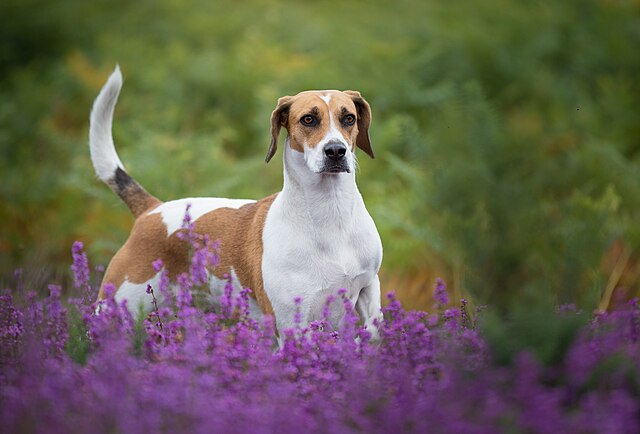


The Harrier is a medium-sized, active hound dog that was originally bred for hunting. Often referred to as a "miniature English Foxhound," the Harrier shares many characteristics with its larger cousin, the English Foxhound, but is more compact and agile. Known for its strong prey drive and excellent sense of smell, the Harrier is still used today in hunting, particularly for tracking hares and rabbits. Despite its hunting background, the Harrier is also a loving and friendly companion dog, making it a good choice for active families.
The Harrier’s origins date back to the 13th century in England. It is believed that the breed was developed by crossing the English Foxhound with smaller hounds, possibly including the Bloodhound. The goal was to create a dog that was smaller and more agile than the Foxhound, yet still capable of tracking and chasing game. The Harrier was originally used to hunt hares and other small game, often in packs. Over time, the breed became a popular hunting dog, though it remained relatively rare and less well-known compared to other hound breeds. Today, the Harrier is still used for hunting, though it has also gained popularity as a family pet due to its friendly nature and athleticism.
The Harrier is a well-proportioned, medium-sized hound with a muscular build and a compact, balanced frame. It stands between 18 and 20 inches tall at the shoulder and typically weighs between 40 and 60 pounds. The breed has a short, dense coat that comes in a variety of colors, including tri-color (black, white, and tan), bi-color (usually tan and white), and lemon (pale yellow and white). The Harrier has a long, straight tail that is carried high and slightly curved at the tip. Its ears are medium-sized, floppy, and hang down close to the head, and its eyes are dark, expressive, and full of energy. Overall, the Harrier’s appearance is sleek and athletic, built for endurance and speed.
The Harrier is known for being friendly, outgoing, and sociable. It is typically good-natured and enjoys being around people and other dogs. Unlike some hounds, which can be aloof or independent, the Harrier is known for its affectionate and people-oriented personality. It is especially good with children and can make a wonderful family pet. However, as a hunting dog, the Harrier also has a strong prey drive and may chase small animals or run off if not properly trained or kept in a secure environment. Despite this instinct, the Harrier is generally easygoing and not overly aggressive, making it a popular companion for active individuals and families.
The Harrier is an active and energetic breed that requires plenty of exercise. Due to its hunting background, the Harrier has high energy levels and loves to run, chase, and explore. Daily walks, jogs, or runs are essential to meet the breed’s exercise needs, along with time spent playing in a securely fenced yard. Because of its stamina and drive, the Harrier excels at dog sports such as agility, obedience, and tracking. Without sufficient physical and mental stimulation, the Harrier can become bored and may develop undesirable behaviors, such as excessive barking or digging. It is important to provide regular outlets for the breed’s energy to keep it healthy and happy.
The Harrier is intelligent and eager to please, which makes it relatively easy to train, especially when positive reinforcement techniques are used. However, like many hound breeds, it can be a bit stubborn and independent at times, so consistency and patience are key. Early socialization is important to help the Harrier develop into a well-rounded dog, as it can be reserved or reactive toward strangers if not properly socialized. Introducing the Harrier to a variety of people, animals, and environments at an early age will help prevent behavioral problems and ensure the dog is confident and well-behaved. The Harrier’s strong prey drive also means that recall training is essential, as it may become easily distracted by scents or small animals.
The Harrier is generally a healthy breed, but like all dogs, it is susceptible to certain health conditions. Some of the most common health issues in Harriers include hip dysplasia, ear infections (due to their floppy ears), and eye problems such as cataracts. Regular veterinary check-ups, a balanced diet, and adequate exercise are crucial to maintaining the breed’s health. Because of their short coat, Harriers require minimal grooming, but it’s important to brush them regularly to remove loose hair and prevent matting. Keeping their ears clean and dry is especially important to avoid infections. Additionally, regular nail trimming, dental care, and eye cleaning are essential parts of the Harrier’s grooming routine.
The average lifespan of a Harrier is between 12 and 15 years. With proper care, including a healthy diet, regular exercise, and routine veterinary visits, many Harriers can live a long and fulfilling life. The breed is generally robust and hardy, but like all dogs, it can be prone to certain genetic health issues. It’s important to monitor the dog’s health as it ages and provide appropriate care to ensure it remains happy and active throughout its life.
© copyright Dog Compendium 2024 - 2025